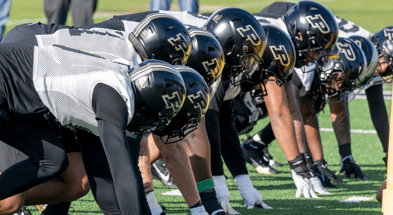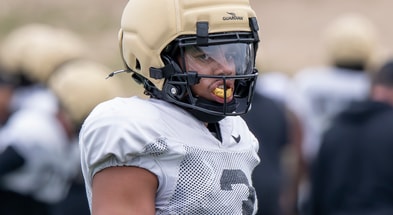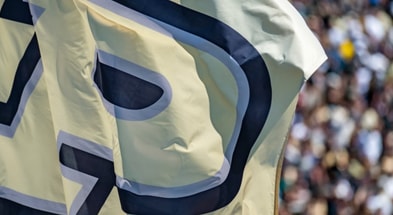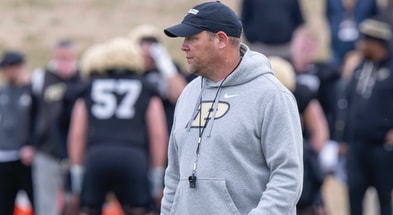The Definitive Hoops 2025-26 Prospectus

Purdue’s basketball season is over, concluding with 24 wins and another Sweet 16 berth, possibly setting the table for much bigger things to come for the Boilermakers in 2025-2026, with what could be its greatest senior class ever.
The transfer portal has already taketh, but also giveth in a big way, and may continue to.
With some pieces established but much more to be determined in coming weeks and months, GoldandBlack.com takes an obnoxiously early — downright irresponsibly early, actually — look ahead to next season.
Take everything at this juncture as a moving part, considering the transfer portal remains open ’til April 22 and non-transfer recruits can be added whenever, but here’s a look at where things stand as of Final Four weekend.

THE FRONTCOURT MIGHT BE LOADED AGAIN
Trey Kaufman-Renn is one of the top players in college basketball, but now flanked by a position/element that may morph from deficiency into strength.
The Boilermakers’ foremost hindrance all season was a lack of size and the obstacles that deficiency created both defensively and in rebounding. You can’t say “center,” per se, was a weakness, because TKR wound up playing center for offensive purposes, though not ideally suited to protect the rim on defense or really control the defensive glass. Playing center amplified some of his offensive strengths but also put him in a tough position in other areas, areas where Purdue then had to out-scheme opponents defensively and simply overachieve on the glass, which it did often.
Now, “center” is transformed. 6-foot-11 Oscar Cluff, perhaps the top center available in this year’s portal cycle and arguably college basketball’s premier rebounder from a season ago, comes in to join 7-foot-3 redshirt freshman Daniel Jacobsen, now healthy after breaking his leg in Game 2 this season. This will be an interior dimension much more in line with what Purdue is used to. Two legitimately towering presences, one of them an elite rebounder and other almost sure to be an elite shot-blocker, the combination of which bound to take a world of pressure off Kaufman-Renn and maybe turn Purdue’s weaknesses this season into strengths. As of this date in April, here is your single biggest multiplier to the Boilermakers’ up-side potential.
Purdue opened this past season preferring to play Kaufman-Renn at forward alongside a 7-footer, but after Jacobsen got hurt and Will Berg never really proved up to the opportunities that came his way, its hand was forced. Now, it’ll get a do-over, with better, more experienced pieces to do it with.
Raleigh Burgess is back as a 4/5 combo, but Job 1 for him right now is to get healthy after shin problems that began during Purdue’s Washington-Oregon swing marred the back half of his season. Time is back on Burgess’ side in terms of his development.
Purdue does probably need to add another combo forward sort of piece still to balance out of the frontcourt, but the anchors for what should be a terrific front line are already in place.
A few other sub-themes to the bigger front-line picture
• This is really important: When TKR came out of games this season, Purdue’s offense sometimes middled. That changed more than a few games.
Now, when he goes to the bench, Purdue is still going to have a post presence on the floor, as it’s likely that Cluff and Jacobsen will each get traditional post touches on offense, with or without Kaufman-Renn on the floor. The way things turned out this season, Kaufman-Renn was really the only player Purdue could throw the ball inside to on a regular basis, thus knocking the offense out of balance when he exited.
• Offensive rebounding should become a real strength again. This has been an enormous, but easily overlooked, common denominator among Purdue’s best teams the past decade or so, and that figures to resume this season, with an outstanding rebounding infrastructure in place and an offensive composition suited ideally to generate higher-value misses and favorable rebounding scenarios.
• Fouls. Size and rebounding presence normally equate to favorable foul balance, which could bring back a measure of the hidden productivity that came from Purdue’s ultimate-size years in the past. There’s no Zach Edey on this team who’ll draw 10 fouls every game, but there’s enough size and physicality and hopeless matchups (Jacobsen’s height) to expect three or four cheapies a game.
Likewise, foul trouble becomes far less of a concern for Kaufman-Renn with Cluff or Jacobsen at his back. Caleb Furst sometimes took the more grueling defensive matchups last season, but there’s no question that the burden put on TKR having to defend and rebound against bigger people is a huge net positive for Purdue.
• Purdue’s going to be bigger than most people again this season, and needs to leverage that, but it does bear mentioning that Jacobsen and Cluff both can shoot threes. Whether they can do it at a level where it’s a preferred shot for Purdue, we’ll see, but they are both capable.
PURDUE PERIMETER
First off, Braden Smith is going to have an NBA decision to make. As of midseason, there was intel out there topping out for him as a possible late first-rounder, and that was before his virtuoso performance against Houston in the NCAA Tournament.
But we all know the lay of the land here these days, and all the same dynamics that applied to Zach Edey coming back for his senior year apply to Smith, though with even more money to be made in college since he doesn’t have the work-visa albatross Edey did. Smith has a shot to become the NCAA’s all-time leader in assists and a national player-of-the-year next season, with as good a shot as anyone to return to the Final Four.
No need to remind you here how good Smith is. Provided he’s back, the Cousy Award winner is the game’s best guard and one of its most influential offensive forces and impactful competitors. He’s an advantage for Purdue against everyone and everyone on the floor with him is 10-20 percent better than they’d be otherwise because of him.
Meanwhile, years-long running mate Fletcher Loyer is one of the steadiest standouts you’re going to find, validated this season beyond a shadow of a doubt as of college basketball’s truly elite shooters and offensive glue guys.
He’s meant more to Purdue’s elite offensive outcomes during his college career than he gets credit for, even as he’s become more and more of a marked man for defenses (or perhaps because of it.)
Top 10
- 1New
Jaydn Ott
Top RB enters transfer portal
- 2Trending
Angel Reese
Reacts to Hailey Van Lith
- 3Hot
Nico Iamaleava
Odds out on next team
- 4
Hunter, Sanders
Colorado jerseys retired
- 5
J.D. Vance
VP drops Ohio State trophy
Get the On3 Top 10 to your inbox every morning
By clicking "Subscribe to Newsletter", I agree to On3's Privacy Notice, Terms, and use of my personal information described therein.
Smith and Loyer are one of the best backcourts in America, and the two classmates have now played 110 games together. How many other teams can say that these days?
Purdue will probably add another ball-handling guard to next year’s mix, but as is now, its up-side lies in the improvement via experience of this past year’s freshmen — CJ Cox and Gicarri Harris. Both of them laid strong foundations this season for the years to come, Cox actually starting most of the season, doing a good job defensively and impacting Purdue with his shot-making and shot-creation, finishing as a 40-percent shooter from three-point range. Harris showed real flashes as a defender, competitor and rebounder and wound up shooting 42 percent from three-point range in Big Ten play after a dreadful early-winter slump. He’ll enter summer as a starter-caliber player.
Watch out for Jack Benter, who redshirted this past season. The upside there is that of a big-time shooter and offensive skill/IQ player and a “good student” as we’ll call it, the sort of player Purdue’s won a lot of games with over the years. We might be underselling him here. Don’t be surprised if come mid-summer, Benter isn’t viewed as a clear rotation guy.
A few other sub-themes to the bigger backcourt picture.
• Even though they got way better during the season, it was made evident this season that the two freshmen are better suited to be off-the-ball players offensively, secondary ball-handlers, so Purdue might look for more point guard capability for next season. Smith can play 40 minutes every game, but it would be optimal if he didn’t have to.
• Purdue is always going to want to be an effective transition-offense team, even with a larger front line, but the transfer losses of Myles Colvin and Camden Heide did cost Purdue its two best open-court athletes. How much does that matter?
PURDUE DEFENSE
The Boilermakers’ lack of size, rim protection and defensive rebounding presence was its albatross all season, or at least from Jacobsen’s injury on, and an obstacle Purdue had to scheme its way around, making for a season of dizzying variance, from the dominance of January to things slipping considerably thereafter, then all of it coming back together in time for the NCAA Tournament, in which Purdue was excellent on defense.
Those last few games might be viewed as a template for the season to come, even though Purdue’s 2024 weaknesses might now become strengths. That said, the new-ish defensive scheme might now be its M.O. moving forward, even with the size issue presumably fixed. The system is built to protect the paint and knock out bad matchups, and those aims aren’t changing now that Purdue has size.
As always, Purdue’s best defense will be good offense, meaning its experience on offense has to translate to minimal turnovers. Purdue was mostly OK there, but when it wasn’t, it was its undoing.
A few other sub-themes to the bigger defensive picture.
• Purdue averaged 1.6 blocked shots per game this season, fewer than everyone in college basketball except Wagner and Northern Arizona. Had Jacobsen made it through like a week, he might have wound up with more blocks than Kaufman-Renn’s eventual team-best 11.
But it’s not just about shot-blocking, but shot-disruption and deterrence of penetration.
Now, again, perhaps a weakness becomes a strength. Cluff wasn’t an elite shot-blocker at South Dakota State, but he was way better than anything Purdue had; Jacobsen may be an elite shot-blocker, perhaps in the short term. And the rebounding part of it is just as important, with two guys now who can be really productive, affording maybe Purdue some defensive margin for error if it doesn’t have to overcompensate for voids on the glass.
The importance of this personnel shift can’t be overstated.
• Losing Myles Colvin took away one of Purdue’s relied-upon on-ball defenders, but Harris and Cox are better built for it, wired for it and now experienced, and perhaps more minutes bring even more out of them in that regard. At its best defensively, Purdue’s ball pressure was a key reason, and if that becomes better and more consistent, then so will the defense as a whole. Purdue did back off its long-standing end-to-end nuisance pressure for the postseason to become more compact in halfcourt defense, which may not be as important with real size on the floor. Regardless, halfcourt ball pressure is more important than full-court pressure.
PURDUE OFFENSE
Most of this has already been outlined in one form or another above, but assuming all the pieces remain in place, Purdue again has all the making of an elite offensive team.
You’ve got the best play-making guard in the country, one of the pre-eminent frontcourt scorers in college basketball and you’ve surrounded them with a 40-percent-capable shooting arsenal and formidable offensive rebounding apparatus.
This won’t be the most athletic team in college basketball, but it could be the most skilled, the smartest and the most complete. It comes down then, to the same old hot button: Turnovers.

























